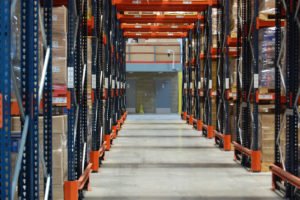The coronavirus pandemic has transformed the way businesses approach the supply chain and will do so for the foreseeable future, continuing to impact on health and safety in warehouses, distribution centres and logistics hubs, says Jim Roberts, Product Manager at Beaverswood.
 A recent study of some of the leading operators in the grocery and home appliance sectors revealed that almost 95% of businesses are looking to re-examine their supply strategies. Moreover, respondents cited the need to re-evaluate their processes at sites and centres across their supply chain operations as being among some of the most important changes expected to support future strategies. And this includes the reassessment of workplace health and safety.
A recent study of some of the leading operators in the grocery and home appliance sectors revealed that almost 95% of businesses are looking to re-examine their supply strategies. Moreover, respondents cited the need to re-evaluate their processes at sites and centres across their supply chain operations as being among some of the most important changes expected to support future strategies. And this includes the reassessment of workplace health and safety.
Supply chain resilience and agility will continue to feature as high priorities, with companies aware of the need to build additional robustness into their frontline operations to cope with any future disruptions. Indeed, learning from the critical issues around health and safety which have come to light in the face of the COVID-19 onslaught, sector operators must re-assess to be prepared for the new ‘normal’ and the real possibility of further disruptions over the next months, including a possible second wave of the virus.
While employers have always had a duty to cut risk in the workplace, businesses endeavouring to realign their activities have to reconsider such possibilities as they strive to keep the existing workforce and workplace safe and secure while looking to invest in additional resources to meet the welcome growth in business, which is being driven by the huge demand for products being purchased through online channels.
Holistic approach
Indeed, the large number of people carrying out their responsibilities under one roof to shift and store goods and load and unload vehicles focuses attention on safety. Under UK law, employers must observe a duty of care to their workforce: they must identify the health and safety risks each person faces at work. In general, this comes into force when a person or group of people do something that might reasonably harm somebody, which includes the possibility of physical injury.
Adopting a holistic approach to mitigating risk, as business realignment occurs in the light of the pandemic, must be seen as the starting point for good practice; a sensible first step. Key to managing risk is assessment – the effective process of evaluating threats to workers’ health and safety from workplace hazards in order to determine the measures required to eliminate or reduce the level of incidents/accidents.
Accidents can occur anywhere in the workplace, but one area that is often considered particularly risker than most is the loading bay. Hazards abound beyond COVID and requirements for social distancing – from ill-fitting canopy seals letting water onto the loading bay floor through to accidents involving delivery vehicles to ‘run-away’, risk can come in many forms. So as lockdown restrictions begin to lift, logistics companies pressing forward to meet the demands of dispatch and delivery will find the increased volume necessitates additional investment and changes to bolster safety in loading areas.
In this environment, investment in integrated dock debris guards and flaps, for example, can provide improved control and containment of industrial waste. As well as containing water ingress they provide a solution for vehicle loading docks, containing waste build-up, which could pose a fire hazard, and inhibiting its spread to other parts of the site.
Wellbeing
Indeed, let’s hope sector operators continue to maintain high standards of safety to protect the wellbeing of staff and customers across their operations as (hopefully) restrictions continue to be relaxed.
The installation of safety barriers for instance, can pay significant dividends, helping to maintain awareness while offering a reassuring presence in an area where it is more than likely a moving vehicle will be present, encouraging people in the warehouse to habitually check their surroundings. This will ensure that they will not step out into the path of any forklifts or loading vehicles – handy assets to have in place when it comes to ensuring workers remain alert and aware of their surroundings.
As well as bearing a significant responsibility for their workforce, employers must take care of visitors, contractors and members of the general public who come on site. Everyone needs to be shielded as far as is practically possible from accidents and injuries while on the premises, both inside and outside of buildings and the surrounding car parks and transport links.
Indeed, the consequences of an accident can have far reaching ramifications for the injured person. It can also take its toll on productivity, finances, growth and investment plans and corporate reputation. It’s therefore critical to consider your operations and identify ways of making them both safer and smarter now and long term.
There’s always room for improvement when it comes to protecting people and property, but now during increased sector growth, it’s the right time to be reassessing your workplace safety measures. However, safer working doesn’t have to be cost prohibitive. There are many simple and cost-effective products that can be self-installed and provide effective safety solutions. Consider your requirements in terms of quality, reliability and performance.
The Safety Conversation Podcast: Listen now!
The Safety Conversation with SHP (previously the Safety and Health Podcast) aims to bring you the latest news, insights and legislation updates in the form of interviews, discussions and panel debates from leading figures within the profession.
Find us on Apple Podcasts, Spotify and Google Podcasts, subscribe and join the conversation today!

 A recent study
A recent study